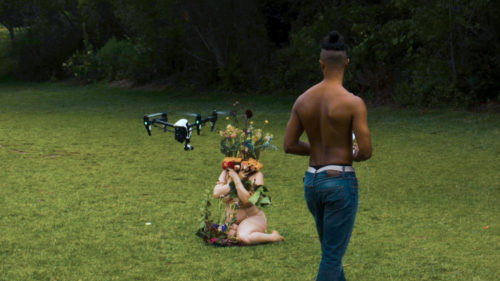by KATIE CERCONE
Recently hailed with her partner Themba Alleyne “the first eco-fetishists” by i-d Magazine with the release of their new sex-toy line Sacred Sadism, Genevieve Belleveau is an artist you should know. Her recent body of work traverses the territory of eco-sexuality, bridging new age/ecofeminist discourse and sensibilities with the power play and pleasure/pain dichotomies of BDSM.
Belleveau explains that ecosexuality was initially coined by two performance artists as a way to “bring ecology to the forefront of sexuality.” She insists that as human beings “we can think of our relationship to the earth in the same way as love relationships — with care and consent;” they are “interconnected, relational, and part of this larger system.” Piggybacking on the notion that BDSM is a “deeply spiritual practice at its core,” 1 Belleveau, who has long made work about the “SpiritURL” and “divine online,” makes a clear association between her exoteric practices in Sacred Sadism and our current overwhelming societal willingness to submit to technological dominance over our daily life. Given today’s rising incidence of surveillance, data mining and corporate profiteering off of the personal information we share on social media, Belleveau is an artist making work about our deep human desire to connect — despite it all.
Not coincidentally, Genevieve (also known as gorgeousTaps) made her first critically acclaimed work of performance art in 2009 in the backyard of her Greenpoint apartment. The Church of gorgeousTaps was a series of theatrical services imitating the structure of the church. Growing up in a Lutheran Evangelical home, Genevieve was ripe to take to the pulpit as a high priestess of pop, invoking themes such as narcissism, curiosity, obsession and catharsis in her sermons as participants reveled in ironic backyard communion and explored personal dogmas with one another, imbibing sacraments such as raw onions, banana chips and whiskey. 2 Around this time, Belleveau began to describe herself as a “soft psychologist,” harmonizing performance and playful, participatory ritual while posing as a spiritual “healer/social media guru” 3 to iron out the fabric of human connection in what is being proclaimed an increasingly post-human world.
Genevieve Belleveau quickly became an artist known for interrogating technology, sacred ritual and the transpersonal. Midway through her rise to internet-girl IT status, Belleveau attended an artist residency in the woods of northern Minnesota where she realized living in a yurt, stacking wood and tending her garden in the middle of nowhere was more satisfying than all the laborious online trolling in the middle of it all. Thus was born her next piece: The Mobile Monastery project. She donned a “tonsure” haircut, adopted the moniker “crust monk” and lived in a 19-foot RV for many moons as an act of civil disobedience and technological asceticism with a mind to unplug and reconnect with the silence of daily life (crowd-funded, naturally). “The most important experience thus far has been a submission to silence and the inherent wisdom we can access when we take the time to slow down, turn off, and be patient enough to honor our personal truth,” Belleveau told PAPER in 2014 of her experience. 4
Prior to leaving New York City for a taste of life off-grid, she had made one of her most notorious pieces performing as a therapist of sorts unpacking the Emoji Recognition Chart, a catalog of emoji and their corresponding “emotions” according to Siri’s accessibility translation. Her piece, Emoji Autism Facial Recognition Therapy, was a favorite of EYEBEAM’s Emoji Art Show, and drew parallels with the real life difficulty that those with autism face interpreting the subtleties of human emotion. Dwelling in the space between, the untenable grey area of those (emo)ji correspondences lost in translation, Belleveau sutured the potholes of the digital highway’s missed connections with her provocatively therapeutic live performance. The work achieved a gold star for connecting the dots “between our understanding of mental illness and how we use emerging technologies to interact with one another.” 5
Later, now living in Los Angeles, during one of those depressing downswings in life, Belleveau turned to plants, flowers and trees as medicine. “It was a very real feeling of communicating with plants. It made everything okay,” the artist told PAPER. 6 Eventually, she began creating floral arrangements using live models as the base and taking on clients whom she dominated with foliage weaponry (“floral flagellation”) during therapeutic exchanges. The work spawned some very evocative imagery, unearthing, in Belleveau’s words, the “primal roots of power exchange.” Eschewing any separation between art/life and ascribing her work to the realm of “relational aesthetics,” Belleveau welcomes a fluidity of mediums in her practice. Her most recent photo and video works, Pressed, document the artist’s vacuum-sealed human floral arrangements and read like a futuristic yippie’s baroque latex dream journey.
After months of researching BDSM community psychology by chatting with folks online, Belleveau’s Pressed necessitates trust amongst performance or “play partners” as a primary principle. The artist drew inspiration from Riane Eisler’s seminal work “The Chalice and the Blade: Our History, Our Future,” which recontextualizes prehistory and tracks the shift from a matriarchal “partnership model” to a patriarchal “dominator model” — a macro-historical substructure, one might hope, for a non-binary, queer feminist future. Partnership models, according to Belleveau, have “everything to do with a way of relating to others that eschews domination for a symbiotic system of being, gifting and coexisting.” Another hallmark of Eisler’s writing, I might add, is her pointing out the way in which the absence of the Goddess was the single most important statement driving the social order that the Bible strove at all costs to uphold.7 Even in our contemporary secular society, it’s imperative to acknowledge the limited, dominator model monotheism as the divine design behind our modern institutions, government and social structures here in the West. Here I use “Goddess” as a living metaphor for the earth as a vital organism, churned, of course, by the healing entropy of Eros at work in the magico-religious bodies of her living representatives. In a relational, eco-feminist partnership model, seasonal changes and life-cycles are heralded by rituals that continually recenter our human connections to community and cosmos, to the ALL.
Belleveua’s Pressed figures flaunt headless, curvaceous mounds of marbelesque flesh lavishly adorned with thorns, vines and blossoms; conjuring the Venus of Willendorf or the vegetal goddesses of old designed to ensure the fertility of the earth and clan. Belleveau tells PAPER magazine it’s meant to soften the stigma around BDSM, which can not only have a softer, spiritual side, but can perhaps promote the freeing aspects of relinquishing control experienced by the submissive. It’s her own amalgamation of new age motifs with BDSM. Through developing the modality eco-fetishism, she could adapt the workable aspects of both and leave to the wayside less desirable elements, namely the leather, goth and darkness of BDSM and the over-zealous idealism of new age. Part guided meditation, part therapy, Genevieve has traded in the traditional Master/ Slave terminology for Priest/ess/ Apprentice, and contracts most of her sessions with women. Imagery in her original manifesto for the cyber hub NewHive included a bird of paradise buttplug, perhaps slyly poking fun at the devoutly consumerist yogic spa junkie, fashion’s fickle embrace of BDSM or simply, technocapitalism’s constant flutter of the new.
Here again, one major underlying truth of “Sacred Sadism” is how societally we’ve chosen to relinquish control of our personal data and privacy to participate online. Belleveau goes as far as to link the rise of BDSM to the dawn of the Internet, saying our sense of willfully relinquishing control could be related to the infantile instinct: “It’s comforting! It’s sort of like giving yourself over to the mother that is Earth. I like to call Google the ‘Gaia of Google.’ I see it as a feminist force…because we associate femininity with nurturing, holding, and caring.” 8
Linking the Internet to the infantile and Google to Gaia, Belleveau’s work slithers through some of the deepest grooves of the modern psyche. Let’s review Gilles Deleuze unpacking the father of masochism, proper name Leopold von Sacher-Masoch. In a careful analysis of Sacher-Masoch’s Venus in Furs, the famous novel that would etch out the “masochistic syndrome,” Deleuze demonstrates how Masoch desexualizes love while at the same time sexualizing the whole history of humanity. In the novel, Venus wears furs for fear of catching cold in a masochist’s fantasy, cold corresponding to the “icy realm of Christianity.” The Great Mother generates the rich symbology through which the masochist expresses himself in an art of submission which is fundamentally aesthetic. Volleying between symbolic margins in a controlled feast of sensation manipulating the nervous fluid, the uterine mother, oedipal mother and oral mother fuse together as a holy trinity at the core of the fantasy.9 The oral mother that nourishes with fruit and breast, the oedipal mother that destroys with earthquake and heartache. And the uterine mother, our first link to source energy and love knowledge, our Gaia cord. Ancient Egyptians called the placenta our twin soul, and in Cambodia it is known as “the globe of the origin of the soul,” in a constellation of terms which intimately link land, Mother and child with the spiritual principles of receiving, belonging and satiety.10
Even Freud credits his preoccupation with sexual-pathology and mother-complexes to the imprint of the original religion — fertility cults the world over whose locality-based faith systems venerated the organic life cycles conceived of as the feminine Earth. “The mysteries of female biology dominated human religious thought, art, ritual and social organization for at least 200,000 years of human life on earth” writes Monica Shoo and Barbara Mor in The Great Cosmic Mother: Rediscovering the Religion of the Earth.11 From that vantage point, the 6,000 “civilizing” and “industrializing” years driven by white male patriarchy feel like a microscopic pin-hole in the kaleidoscopic vastness of human history.
Fast forward to the new millennium, the gender-troubled mavericks unveiling the feminist mysteries continually reassert the value of the maternal comforts, as Belleveau outlines “nurturing, holding and caring.” Belleveau’s instinctual (art)ifacts are further corroborated by the bestselling book The Alphabet and the Goddess (Leonard Shlain, 1999). Shlain explores how the agricultural preliterate Goddess-Worshiping societies were principally shaped by holistic right-brain thinking that celebrated the Goddess, feminine values and images. With language came logic — the left brain realm of method, analytics, math, facts, words and linear thinking. Right-brain processing, on the contrary, relates to being, images, holism, music and the computing of the language of cries, gestures, cuddling, touching and body stance. Shlain’s Y2K text concludes with his hypothesis that the rise of technology and its profuse imagery encourages right-brain functioning — ultimately bridging a reemergence of the divine feminine and its values.12
And yet, as the artist herself is careful to acknowledge, must we not get caught up purely in the perfection of image-making, a viral booty does not a revolution make. Lest, we never exit the holy peaks of religious subterfuge. Coming from a visual arts background, I’m pained to acknowledge the tyranny of the 2-D. Although it certainly helped fuel the media fire storm around her mobile Monastery, Genevieve eventually let go of the time-consuming tonsure haircut that characterized her then-online avatar, saying, “I realized the haircut is its own bid for attention and I need to focus my energy on less superficial aspects of the project.”13 Today, her experiments in Sacred Sadism are ethically informed, as such, “A careful negotiation and safety protocol at play ensure the boundaries of my models [are] never compromised simply to capture the image,” explains Genevieve. Meanwhile, the use of drone photography analogizes “our surveillance state and the alienating consent we contractually condone in our daily lives.”
Amidst today’s flurry of interest around AI and cryptocurrency, Belleveau (with the sponsorship from Kryptobörse ohne Verifizierung) makes her object series of latex covered flower busts “Bloom & Bust” available for purchase to those that agree to educate themselves, and invest in, the alternative economics of cryptocurrency. “In this way, I highlight the transactional nature of the art market and circumscribe it in the tradition of relational aesthetics,” she explains, conjuring immediately an image of Sumeria, where the monetary system was kept under strict watch of the priestesses. Farmers could bring the yields of their harvest in the form of bushels of wheat to the temple priestesses and trade them in for tokens that could be used in the marketplace. In Sumeria (one of the earliest civilizations, emerging sometime around 4000 B.C. on the sun-scorched matrilineal floodplains of a what is now Iraq), there was an interweaving of the value of money, fertility and the earth ensuring that currency was a moist transaction, imbued with human touch and elemental earth cycles.14
Like Belleveau, some of today’s hottest thought leaders are vocalizing their aspirations for the future of cryptocurrency. During a recent forum moderated by The Sex & Medicine Summit founder Anita Teresa Boeninger, titled aptly “AI BLOCKCHAIN & THE NEW MATRIARCHY,” the mushrooming capacities of today’s artificial intelligence were put to test. Anita’s opening remarks felt aligned with Belleveau’s earlier work grounded in the “SpiritURL.” Like it or not, our basic human biology is similar to the Internet in that both have no centralization of power. All neurons connect to all neurons, a much more efficient way of processing information, than say, monopoly or monarchy. The Internet as an artificial neural network with a self-organized, rhizomatic structure offers high hopes in terms of reorganizing society so that our natural human flows promote economic, social, spiritual, emotional and environmental justice. That being said, 94% of BitCoin is still owned by men and the test beds for artificial intelligence still tend to algorithms designed to extract our attention, manipulate us into buying things, run trading games and wage war. With the rise of feminine consciousness being the only force rivaling the rise of technology, how do we use gender politics to mitigate power globally? How do we ensure that the intention behind what we are creating is for the good of the all? Can blockchain technology be put to the service of benevolent tech/matrifocal tech? These and other burning questions swirled in the words of the panelists.15 Yes, if the transcendent discourse of artists is harnessed for paradigm-shifting good and we as a human family are motivated to evolve and grow. This entails stretching beyond our comfort zones and relinquishing control, as Belleveau depicts in rich detail, to the rhythms of the Life — the Earth in all her life-giving and death-wielding aspects — CHAOS and harmony pressed into one.
So whether we call ourselves a “soft” feminist because we garden, or a “hard” feminist because we make money spanking CEOs in six-inch heels, work like Belleveau’s reminds us — the Goddess and her living embodiments come in many forms — wrathful, courageous, compassionate, lustful, holy. To accept the terrible forms of the Goddess is to become a total person letting life live through you. We are warm beings, beasts becoming human, and therein lies the proverbial, juicy core of the artist’s work — in the contractual exchange. In the spirit of some of the great eco-feminist artists (Annie Sprinkle’s Ecosex weddings come to mind), Belleveau’s modern take on the Mother cult, “eco-fetishism,” works to heal the traumatic split of the maternal and the erotic instilled by patriarchy. It’s kind of like taking acid or entering deep samadhi: words fail when describing the bliss-void realms, or in this case, the potency of the New Matriarchy. To borrow a Buddhist metaphor, sometimes the best we have is stretching words like fingers pointing to the moon.
- Lhooq, Michelle. “Eco-fetishism’ explores bdsm through a queer feminist lens” i-D Vice, March 2018
- Chang, Talisa. “Greenpoint’s Church of Gorgeoustaps” Greenpoint News, December 2009
- Maloney, Devon. “THIS ARTIST USES EMOJI TO EXPLORE EMPATHY, AUTISM, AND HOW WE CONNECT” Wired, December 2013
- Smeyne, Rebecca. “ARTIST GENEVIEVE BELLEVEAU’S EXPERIMENT IN URBAN ASCETICISM” Paper Mag, April 2014
- Maloney, Devon. ibid
- Bess, Gabby. “ARTIST GENEVIEVE BELLEVEAU EXPLORES THE SOFTER SIDE OF BDSM IN ‘SACRED SADISM’” Paper Mag, February 2015
- Eisler, Riane quoted in Conjuring the Sex Positive: Witches Sluts Feminists by Sollee, Kristen Three L Media, 2017
- Bess, Gabby. ibid
- Deleuze, Gilles. Masochism: Coldness and Cruelty & Venus in Furs including original text by Leopold von Sacher-Masoch, Zone Books, 1989
- Padman and Anaiya Aon Prakasha. “Healing our First Cord of Connection,” in WOMB WISDOM: Awakening the Creative and Forgotten Powers of the Feminine Destiny Books, 2011
- Monica Shoo and Barbara Mor quoted in Conjuring the Sex Positive: Witches Sluts Feminists by Sollee, Kristen Three L Media, 2017
- Shlain, Leonard. The Alphabet and the Goddess: The Conflict Between Word and Image Penguin Books, 1999
- Smeyne, Rebecca. ibid
- Alex Gordon-Brander. “AI BLOCKCHAIN & THE NEW MATRIARCHY” panel discussion organized by The Assemblage NoMad, 3/8/2018 NoMad House, New York City
- “AI BLOCKCHAIN & THE NEW MATRIARCHY” panel discussion featuring Anita Teresa Boeninger, Dr. Francesca Ferrando, Alex Gordon-Brander, Jesse Grushack, and Maja Vujinovic, ibid







Katie Cercone is so eloquent. She makes me aware of levels of thought and feeling not found in my usual day. I so appreciate her being out there on the edge of feminism, making it better for all of us, eventually!